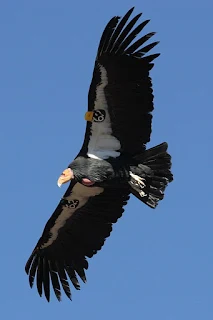25+ Interesting Facts About Vultures
- Vulture is the most famous scavenger among birds. It is present on all continents except Australia and Antarctica.
- Vultures are among the few land birds that can remain in the air for long periods without flapping their wings. They do so thanks to low wing loading and low aspect ratio of wings. (Source)
- It is a myth that vultures circle dead or dying animals. They sit and patiently wait for the death of a dying animal. They mostly circle high in the sky while searching for food. (Source)
- There are mainly two types of vultures according to their location. These are Old World vultures (present in Asia, Africa, and Europe) and New World vultures (present in the Americas).
- The Ruppell’s griffon vulture is the highest flying bird on earth. It can fly at an altitude of 37,000 ft. (11,300 m). Bearded vultures and Andean condors are the world’s 6th and 7th highest-flying birds. They can achieve an elevation of 24,000 feet and 21,300 feet, respectively. (Source)
- California
condor and Andean condor are the largest flying land birds in the western
hemisphere. The California condor is the largest bird in terms of body length (4.5
feet). On the other hand, the Andean condor is the largest bird regarding wingspan
(10.5 feet) and weight (33 pounds).

California condor is largest flying land bird in western hemisphere - A vital feature in most species of vultures is their bald head and neck. The baldness in these areas is helpful for the bird to keep itself cool in a warm environment. (Source)
- There are 23 species of vultures. 16 belong to the Old World family, while the remaining seven are native to the New World.
- Two species of New World vultures are known as condors (Andean condor and California condor).
- Vultures have one of the most powerful digestive systems in the world that allows them to eat any dead vertebrate (bird, mammal, fish, snake, etc.). The strong stomach acid in vultures destroys many dangerous bacteria that are pathogenic in humans and other animals. (Source)
- The greatest threat to the existence of vultures is the presence of toxins in the animals they eat. In the past, the number of vultures decreased sharply in North America and India due to poisoning of their food. Currently, these birds are facing the same issues in Sub-Saharan Africa. (Source)
- The Egyptian vulture is the world’s only vulture that uses tools. It can effectively use pebbles and twigs for hunting and nest building. It was known as “pharaoh’s chicken” in Ancient Egypt. (Source)
- Vultures can eat more food than their requirement in a sitting and store extra food in their crop, a throat pouch. These birds can use it later in times of scarcity of food or for feeding their young.
- Most of the Old World vultures find their prey through sight. For this purpose, they form groups to find the food (carcass) as early as possible. This necessity makes them one of the most social of all large birds. (Source)
- Comparatively, most New World vultures have a better sense of smell. The best among them in this regard is the Turkey vulture. They can easily find both concealed and unconcealed carcasses, thanks to their strong sense of smell. (Source)
- In Africa, eagles assist vultures in finding prey through their sharp eyes. Vultures also wait for eagles to tear open carcasses via their powerful beaks, as it is also impossible for them. (Source)
- Most species of vultures rely solely on carcasses for food, but there are exceptions also. A famous one is the aggressive black vulture. It is known for habitually attacking and eating small animals like goats, lambs, calves, and wild animals. (Source)
- Palm-nut vulture has a different diet compared to other species of vultures. Palm-nut vulture is primarily vegetarian that consumes 70% of its diet from plant sources (palm, dates, fruits, and nuts). It occasionally eats fish, crabs, turtles, etc. as animal food.
- The bearded vulture is the only animal whose main diet comprises bones. This bird fulfills around 90% of its dietary requirement by eating the bones of other animals. They are skilled in smashing the bones by throwing them from a great height on rocks below. The extra-long intestinal tract and highly acidic gastric juice help the vulture to digest these bones easily. (Source)

Bearded vulture is the only animal that primarily eats bones
- Vultures assist humans and the environment in several ways. Their eating of carrion keeps wildlife diseases in check. They can neutralize harmful bacteria and other organisms in a carcass. In their absence or decline, as seen in India, diseases like rabies can spread through dogs and other part-time scavengers. Vultures also sterilize the ground around the dead body through their acidic defecation.
- Vultures usually don’t attack healthy animals. But they may attack injured, very sick, or near-dead animals.
- Black vultures regurgitate undigested food for several purposes. They do so either to feed semi-solid food to young ones or to fly high in a time of danger. (Source)
- Vultures usually live between 10 and 30 years of age. The oldest vulture was a captive female who died in 2015 at age 49.
- Black vultures and California condor are known species of vultures that mate for life.
- New World vultures have weak and flat feet, which are unsuitable for grasping prey. Comparatively, old-world vultures have strong feet.
- New World vultures are almost silent due to the absence of the syrinx (vocal organ of birds). They can only hiss and grunt.



Comments
Post a Comment